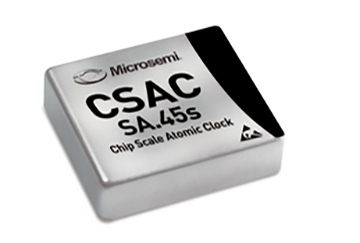
Microsemi Corporation, a wholly owned subsidiary of Microchip Technology Inc. (Nasdaq: MCHP), has launched their SA.45s Commercial Space Chip Scale Atomic Clock (CSAC), the industry’s first commercially available, radiation-tolerant, CSAC. Ideally suited for LEO applications, the device provides the accuracy and stability of atomic clock technology while achieving significant breakthroughs in reduced size, weight and power (SWaP) consumption.

As the newest member of Microsemi’s CSAC product family, the Commercial Space CSAC provides excellent drift performance and built-in 1 pulse per second (PPS) input for GPS disciplining, making the device well-suited for holdover applications. It is targeted at several other commercial space and space research applications, including:
- Satellite timing and frequency control
- Satellite cross linking
- Assured position, navigation and timing
- Earth Observation
With many spacecraft manufacturers turning to commercial off-the-shelf (COTS) parts to meet performance, schedule and cost requirements, the Commercial Space CSAC offers a solution for many satellite missions. According to a market intelligence report by Euroconsult titled, “Satellites to be Built & Launched by 2026 World Market Survey,” the total revenue for satellite manufacture and launch is expected to be US$304 billion between 2017-2026. With revenues of US$102 billion, LEO is expected to account for a third of the total market, with 82 percent derived from satellite manufacturing.
As a stand-alone atomic clock with a 10 megahertz (MHz), CMOS-compatible output, Microsemi’s Commercial Space CSAC is a timing module providing an impressive short-term stability (Allan Deviation) and frequency stability across the operating temperature (TempCo). A standard CMOS-level RS-232 serial interface is built into the device, which is used to control and calibrate the unit and provide a comprehensive set of status monitors.
The interface is also used to set and read the CSAC’s precise internal time-of-day clock. Microsemi’s radiation-tolerant ruggedized oscillators also include OCXOs and state-of-the art EMXOs for applications that require higher accuracy and can support higher power consumption. Learn more at this direct infolink...
Other key features include:
- Power consumption of less than 120 milliwatts (mW)
- Less than 17 cubic centimeters volume (1.6" × 1.39" × 0.45")
- Radiation-tolerant: 20 krad
- Single event latch-up (SEL) and single event upset (SEU) tested to 64 megaelectron-volts per square centimeter/milligram (Mev-cm2/mg)
- Short-term stability (Allan Deviation) of 3.0 × 10–10 at TAU = 1 sec
- Frequency stability across temperature range (TempCo) less than 5x10-10
- 1PPS output and 1PPS input for synchronization and time-keeping
- RS-232 interface for monitoring and control
Peter Cash, the Director of the clock business unit at Microsemi, said that with the introduction of the Commercial Space CSAC, the company now offers a space-deployable atomic precision clock reference with radiation tolerance in support of the space market’s desire to reduce mission costs and design times using COTS devices. As the first atomic reference clock with low SWaP available for space, the firm's new device is well-suited to applications requiring precise clock synchronization, including a variety of existing and emerging LEO applications.
Tim Lynch, GM, Mission Solutions at Harris Corporation’s Space and Intelligence Systems segment (NYSE: HRS), added that the company provides the world’s most advanced sensors, payloads and communications technologies; receiving and information processing systems; and analytics which provide Harris customers with the integrated information and actionable intelligence they need for mission and business success. Microsemi’s latest atomic clock will support Harris in delivering complete mission solutions to the firm's customers.

